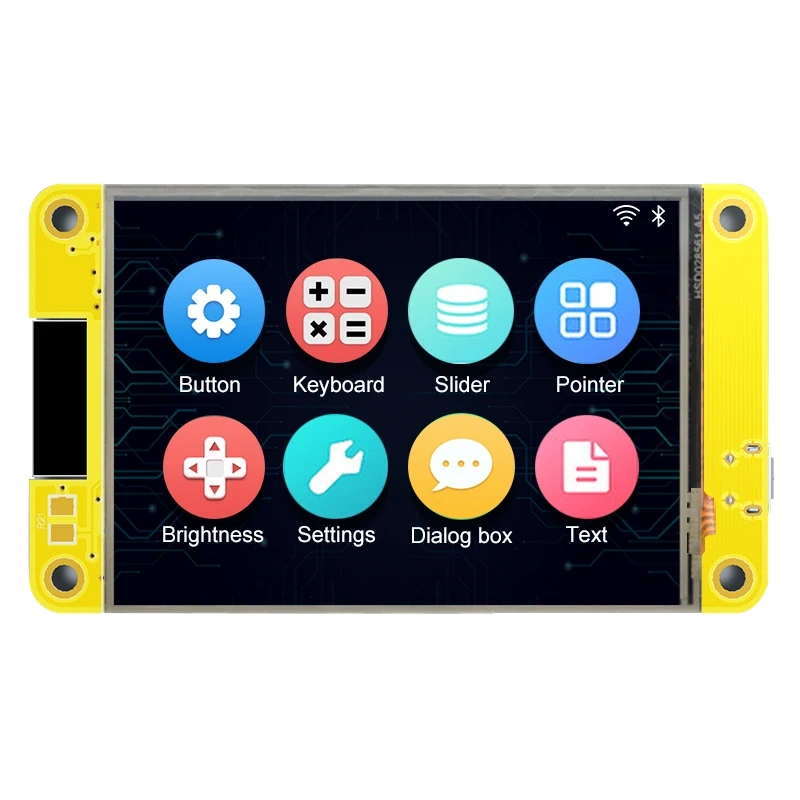Sunton 2.8" 240*320 CYD Display (ESP32-2432S028R)

Available from:
Aliexpress.com
Amazon.com
Aliexpress.com
Aliexpress.com
Install method:
USB to Serial
| GPIO # | Component |
|---|---|
| GPIO00 | Option A3 |
| GPIO01 | User |
| GPIO02 | SPI DC |
| GPIO03 | None |
| GPIO04 | PWM_i 1 |
| GPIO05 | None |
| GPIO09 | User |
| GPIO10 | User |
| GPIO12 | SPI MISO |
| GPIO13 | SPI MOSI |
| GPIO14 | SPI CLK |
| GPIO15 | SPI CS |
| GPIO16 | PWM_i 2 |
| GPIO17 | PWM_i 3 |
| GPIO18 | User |
| GPIO19 | User |
| GPIO20 | None |
| GPIO21 | BkLight |
| GPIO22 | User |
| GPIO23 | User |
| GPIO24 | None |
| GPIO25 | SPI CLK 2 |
| GPIO26 | Buzzer |
| GPIO27 | User |
| GPIO6 | None |
| GPIO7 | None |
| GPIO8 | None |
| GPIO11 | None |
| GPIO32 | SPI MOSI 2 |
| GPIO33 | XPT2046 CS |
| GPIO34 | ADC Light |
| GPIO35 | User |
| GPIO36 | None |
| GPIO37 | None |
| GPIO38 | None |
| GPIO39 | SPI MISO 2 |
Configuration for ESP32
{"NAME":"ESP32-2432S028","GPIO":[6210,1,800,0,448,0,1,1,672,704,736,768,449,450,1,1,0,992,1,1,0,737,480,1,0,0,0,0,705,7264,4768,1,0,0,0,673],"FLAG":0,"BASE":1}Flashing
Flash using Tasmota Web Installer and select tasmota32-lvgl option.For esptool.py download f.e.
tasmota32-lvgl.factory.bin
and run esptool.py write_flash 0x0 tasmota32-lvgl.factory.bin.
Use the tasmota32-lvgl image when flashing.
The following contents should be copied to the filesystem as display.ini
:H,ILI9341,240,320,16,SPI,1,*,*,*,*,*,*,*,40
:S,2,1,1,0,40,20
:r,1
:I
EF,3,03,80,02
CF,3,00,C1,30
ED,4,64,03,12,81
E8,3,85,00,78
CB,5,39,2C,00,34,02
F7,1,20
EA,2,00,00
C0,1,23
C1,1,10
C5,2,3e,28
C7,1,86
36,1,48
37,1,00
3A,1,55
B1,2,00,18
B6,3,08,82,27
F2,1,00
26,1,01
E0,0F,0F,31,2B,0C,0E,08,4E,F1,37,07,10,03,0E,09,00
E1,0F,00,0E,14,03,11,07,31,C1,48,08,0F,0C,31,36,0F
11,80
29,80
:o,28
:O,29
:A,2A,2B,2C,16
:R,36
:0,48,00,00,00
:1,28,00,00,00
:2,88,00,00,00
:3,E8,00,00,00
:i,20,21
:TS,33,-1,2
:B,20,0
:M,150,2780,150,5100
#
The following berry code should be copied to the filesystem as autoexec.be
#- start LVGL and init environment -#
lv.start()
# var scr1 = lv.obj_create(None, None);
# var scr2 = lv.obj_create(None, None);
# lv.scr_load(scr1);
hres = lv.get_hor_res() # should be 320
vres = lv.get_ver_res() # should be 240
scr = lv.scr_act() # default screen object
f20 = lv.montserrat_font(20) # load embedded Montserrat 20
f28 = lv.montserrat_font(28) # load embedded Montserrat 28
#- Background with a gradient from black #000000 (bottom) to dark blue #0000A0 (top) -#
scr.set_style_bg_color(lv.color(0x000000), lv.PART_MAIN | lv.STATE_DEFAULT)
scr.set_style_bg_grad_color(lv.color(0x000000), lv.PART_MAIN | lv.STATE_DEFAULT)
scr.set_style_bg_grad_dir(lv.GRAD_DIR_VER, lv.PART_MAIN | lv.STATE_DEFAULT)
#- Upper state line -#
stat_line = lv.label(scr)
if f28 != nil stat_line.set_style_text_font(f28, lv.PART_MAIN | lv.STATE_DEFAULT) end
stat_line.set_long_mode(lv.LABEL_LONG_SCROLL) # auto scrolling if text does not fit
stat_line.set_width(hres)
stat_line.set_align(lv.TEXT_ALIGN_LEFT) # align text left
stat_line.set_style_bg_color(lv.color(0xD00000), lv.PART_MAIN | lv.STATE_DEFAULT) # background #000088
stat_line.set_style_bg_opa(lv.OPA_COVER, lv.PART_MAIN | lv.STATE_DEFAULT) # 100% background opacity
stat_line.set_style_text_color(lv.color(0xFFFFFF), lv.PART_MAIN | lv.STATE_DEFAULT) # text color #FFFFFF
stat_line.set_text("Tasmota")
stat_line.refr_size() # new in LVGL8
stat_line.refr_pos() # new in LVGL8
#- display wifi strength indicator icon (for professionals ;) -#
wifi_icon = lv_wifi_arcs_icon(stat_line) # the widget takes care of positioning and driver stuff
clock_icon = lv_clock_icon(stat_line)
#- create a style for the buttons -#
btn_style = lv.style()
btn_style.set_radius(10) # radius of rounded corners
btn_style.set_bg_opa(lv.OPA_COVER) # 100% backgrond opacity
if f20 != nil btn_style.set_text_font(f20) end # set font to Montserrat 20
btn_style.set_bg_color(lv.color(0x1fa3ec)) # background color #1FA3EC (Tasmota Blue)
btn_style.set_border_color(lv.color(0x0000FF)) # border color #0000FF
btn_style.set_text_color(lv.color(0xFFFFFF)) # text color white #FFFFFF
#- create buttons -#
prev_btn = lv.btn(scr) # create button with main screen as parent
prev_btn.set_pos(20,vres-40) # position of button
prev_btn.set_size(80, 30) # size of button
prev_btn.add_style(btn_style, lv.PART_MAIN | lv.STATE_DEFAULT) # style of button
prev_label = lv.label(prev_btn) # create a label as sub-object
prev_label.set_text("<") # set label text
prev_label.center()
next_btn = lv.btn(scr) # right button
next_btn.set_pos(220,vres-40)
next_btn.set_size(80, 30)
next_btn.add_style(btn_style, lv.PART_MAIN | lv.STATE_DEFAULT)
next_label = lv.label(next_btn)
next_label.set_text(">")
next_label.center()
home_btn = lv.btn(scr) # center button
home_btn.set_pos(120,vres-40)
home_btn.set_size(80, 30)
home_btn.add_style(btn_style, lv.PART_MAIN | lv.STATE_DEFAULT)
home_label = lv.label(home_btn)
home_label.set_text(lv.SYMBOL_OK) # set text as Home icon
home_label.center()
#- callback function when a button is pressed, react to EVENT_CLICKED event -#
def btn_clicked_cb(obj, event)
var btn = "Unknown"
if obj == prev_btn btn = "Prev"
elif obj == next_btn btn = "Next"
elif obj == home_btn btn = "Home"
end
print(btn, "button pressed")
tasmota.cmd("buzzer 1")
tasmota.publish("tele/tasmota232/SENSOR/Buttom",btn)
end
def buzzer_enable()
tasmota.cmd("buzzerpwm 1") # use PWM on buzzer pin (GPIO21)
tasmota.cmd("pwmfrequency 1000") # highest volume at 2700 as per datasheet of LET7525AS-3.6L-2.7-15-R
tasmota.cmd("setoption111 1")
end
buzzer_enable()
prev_btn.add_event_cb(btn_clicked_cb, lv.EVENT_CLICKED, 0)
next_btn.add_event_cb(btn_clicked_cb, lv.EVENT_CLICKED, 0)
home_btn.add_event_cb(btn_clicked_cb, lv.EVENT_CLICKED, 0)
def slider_event_cb(obj, event)
var slider = "Unknown"
var value = "999"
if obj == slider slider= "SLIDER"
# elif obj == next_slider slider= "Next"
# elif obj == home_btn slider= "Home"
end
value= obj.get_value()
# Refresh the text
# label.set_text(str(value))
print("slider set:", str(value))
tasmota.publish("tele/ESP32-2432S028/SENSOR/Slider", str(value))
end
# Create a slider in the center of the display
slider = lv.slider(scr)
slider.set_pos(20,vres-80)
slider.set_width(200) # Set the width
slider.center() # Align to the center of the parent (screen)
slider.add_event_cb(slider_event_cb, lv.EVENT_VALUE_CHANGED, None) # Assign an event function
# Create a label below the slider
label = lv.label(scr)
label.set_text("0")
label.align_to(slider, lv.ALIGN_OUT_TOP_MID, 0, -15) # Align below the slider
def dropdown_changed_cb(obj, event)
var option = "Unknown"
var modes = ['Auto', 'Boost', 'On', 'Off', 'Adv', 'Day' ]
var code = event.get_code()
if code == lv.EVENT_VALUE_CHANGED
print("Dropdown code :", code )
option = obj.get_selected()
print("Dropdown set:", modes[option])
tasmota.publish("tele/ESP32-2432S028/SENSOR/Dropdown", modes[option] )
end
end
var modes = ['Auto', 'Boost', 'On', 'Off', 'Adv', 'Day' ]
var modes_str = modes.concat('\n')
ddlist = lv.dropdown(scr)
ddlist.set_options(modes_str)
ddlist.set_pos(20,vres-180)
# ddlist.center()
ddlist.add_event_cb(dropdown_changed_cb, lv.EVENT_ALL, None)




